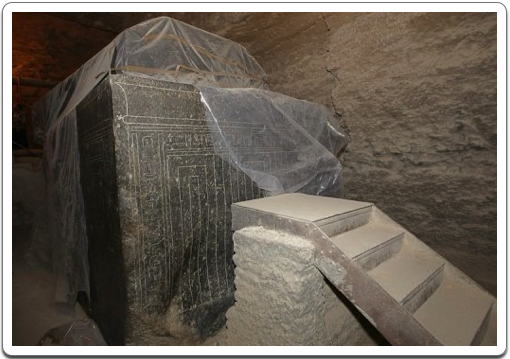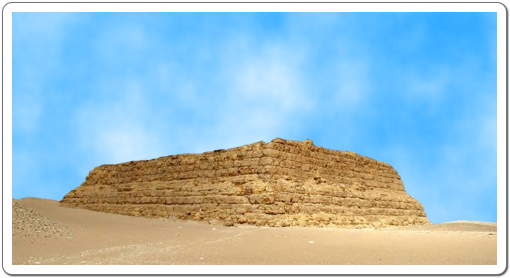Saqqara is located near the entrance of the Nile Delta, at the point where the river starts dividing into several arms, on the west bank of the Nile. Its first tombs, dated to the beginning of the 1st Dynasty, were built on the ridge of the desert plateau, probably immediately to the west of the new capital of Memphis.
On a clear day, its most prominent monument, Netjerikhet’s Step Pyramid, can be seen from Giza, which lies some 17 kilometres to the North, and from Dashur, about 10 kilometres to the South. From Egypt’s modern-day capital, Cairo, Saqqara is located some 40 kilometres to the southwest.

Netjerikhet’s funerary complex seen from the sky.
Source: Lehner, Complete Pyramids, Thames & Hudson 1997, pp. 86 & 91
Its northern most monuments, the Archaic Tombs, are located slightly to the south of the 5th Dynasty necropolis of Abusir. It is believed by some that the oldest remains of Memphis are to be found underneath the modern-day village of Abusir, immediately to the east of the Archaic Tombs.
To the south, Saqqara borders on Dashur, which some Egyptologists consider only to have been an extension of Saqqara. Against this view, however, it must be noted that when the first pyramids were built at Dashur, in the beginning of the 4th Dynasty, there was a large area of unexploited desert between the two sites. The southern-most royal monument at Saqqara was built by Shepseskaf, the last king of the 4th Dynasty.

Interactive map of Saqqara. Hover over the map and click or tap the red circles to learn more about the many monuments at this site.
Throughout its almost 3.000 year long history, Saqqara expanded to cover an area of 6 kilometers from north to south by 1,5 kilometers from east to west. As such, it is one of the largest and most important areas of the Memphite necropolis.
This 9 square kilometers area is usually divided into two parts: Saqqara-North and Saqqara-South, which, in turn, can be divided into smaller necropoleis.
Saqqara North
Saqqara North stretches between the Archaic Tombs just south of Abusir, and the unfinished complex of Sekhemkhet. It can be divided into the following cemeteries:
- Northern cemetery: This cemetery was an extension to the west of the Archaic Tombs that were built on the edge of the Saqqara plateau during the 1st Dynasty. It was used and extended during the Old Kingdom, with most of the oldest mastabas closest to the Archaic Tombs. The large majority of these mastabas are dated to the 5th and 6th Dynasty and only a few to the 4th. This can be explained by the fact that during the larger part of the 4th Dynasty, Giza was the main burial place and by the fact that there appear to have been fewer high officials during this 4th Dynasty.
To the west of the Old Kingdom necropolis are located several cemeteries for the embalmed remains of the sacred animals.

Massive sarcophagus of a deceased sacred Apis bull in the Serapeum at Saqqara.
Source: Phys.org.
- Teti cemetery: Before Teti built his pyramid at the southern extension of the row of Archaic Tombs, this part of Saqqara appears to have been virtually unexploited. Several of Teti's high officials chose to build their mastabas directly to the North of their king's monument. Among them is the mastaba of vizier Mereruka.
The cemetery continued to be used well into the 1st Intermediate Period. During the Middle Kingdom and the 2nd Intermediate Period few burials were made here, but when, from the first half of the New Kingdom on, when nearby Memphis regained its importance, it became popular again. The use of this cemetery in the New Kingdom is closely related to the worship Teti enjoyed during this period, but it is not clear what was the cause of what: did the New Kingdom Memphites grant Teti a special status because of the extended use of his cemetery, or did they chose this cemetery because of his already established status? - Netjerikhet cemetery: To the north and west of the Djoser complex, several tombs were built during the 3rd Dynasty and later. Among these tombs, the mastaba of Ptahhotep of the 5th Dynasty is the most famous.
To the west of this cemetery, a gallery of tombs for the sacred bulls of Apis, and known today by its Greek name Serapeum, was constructed from the 19th Dynasty on. It would continue to be used until well into the Roman Period. - Unas cemeteries: To the north and the south of the causeway of Unas' mortuary complex evolved several cemeteries.
- The north cemetery consists mainly of late 5th Dynasty tombs, with the tombs of two of Unas' queens. Its tombs were built between and on top of the tombs of Hotepsekhemwi and Ninetjer, which are, perhaps, the oldest royal tombs at Saqqara.
- The area south of the causeway was developed mainly from the late 18th Dynasty on. It contains such tombs as those of Horemheb and Maya, which are considered to be among the most beautiful tombs in Saqqara.
- The areas around the unfinished pyramid of Sekhemkhet and the so-called Great Enclosure have not yet been fully explored.
Saqqara South
At some distance to the South of Sekhemkhet's unfinished complex, three kings built their pyramids. The first was Djedkare of the 5th Dynasty, whose attention may have been drawn by the high plateau that dominates this part of the area. He was also the first king to return to Saqqara after several of his predecessors had preferred Abusir, to the North of Saqqara, for their burials.
The two other royal monuments built here belong to Pepi I and his son Merenre I, both of the 6th Dynasty. Such was the importance or fame of Pepi I's funerary complex, that its name, mn-nfr was applied to the nearby city of Memphis by later generations. It is possible that during Pepi's time, Memphis, which probably had started out along the East-side of the edge of the Northern plateau of Saqqara, had grown to have its centre located almost directly to the East of Pepi's pyramid. Archaeological research in and around this pyramid, conducted by the French in the 1980’s and 1990's has revealed several smaller pyramids that were used for the burial of Pepi I's many queens.
Further to the South still the oldest royal tomb that was constructed at Saqqara-South also marks the the southernmost point of the site. The uniquely shaped tomb of Shepseskaf is paralleled only by the tomb of Queen Khentkaus I at Giza, approximately dated to the same period.

The oddly shaped tomb of Shepseskaf at Saqqara.
The penultimate and last royal funerary monuments that were built at Saqqara are the pyramid complex of Pepi II, at some distance to the northwest of Shepseskaf’s tomb; and the small pyramid of Ibi, to the Northeast.
Saqqara-South requires much more research for us to better understand not only the evolution of Saqqara as the most important Memphite necropolis, but also of the history of Egypt as a whole.